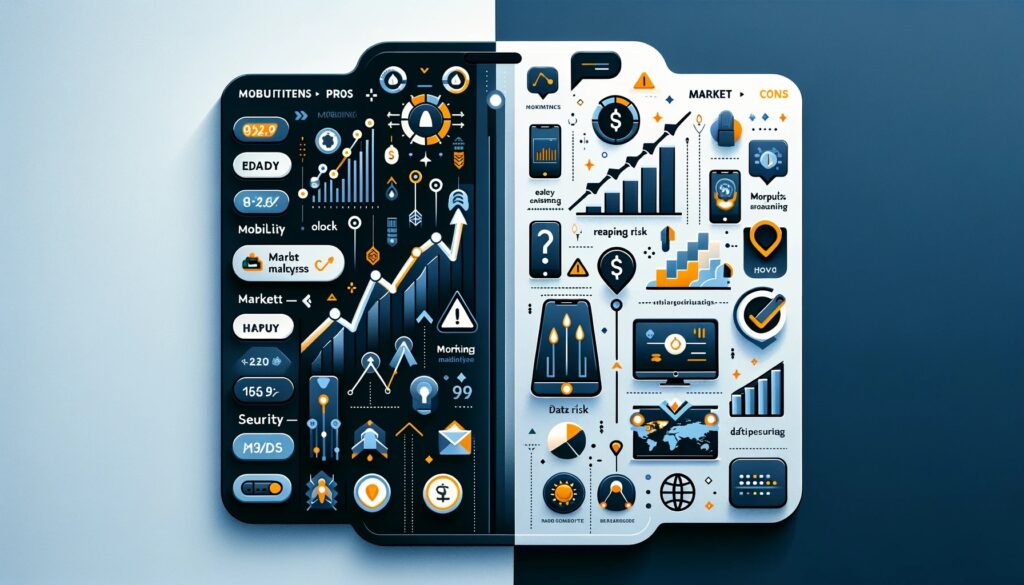In today’s digital age, forex trading apps have become an indispensable tool for traders worldwide. These platforms offer the flexibility to trade and manage investments from virtually anywhere, fostering a new era of trading that’s defined by accessibility and immediacy. However, as with any significant technological shift, the transition from traditional trading methods to app-based platforms comes with a unique set of advantages and challenges. This comprehensive analysis aims to shed light on the multifaceted impact of trading apps on the trading landscape, offering insights into their benefits and potential pitfalls.
Introduction
The inception of forex trading apps has marked a pivotal shift in how currency trading is conducted. By leveraging sophisticated technology, these apps provide traders with real-time market data, advanced analytical tools, and the ability to execute trades at the touch of a button. This evolution has democratized forex trading, making it accessible to a broader audience than ever before.

The Evolution of Forex Trading
From Traditional to Digital: A Brief History
The journey from floor trading to digital platforms has been transformative. Traditional forex trading was once reserved for financial institutions and professionals, requiring access to trading floors or complex telephone-based trading systems. The introduction of online trading platforms was the first step in democratizing access, but the advent of forex trading apps has truly revolutionized the landscape, offering unparalleled accessibility and flexibility.
The Technological Leap: How Apps Changed the Game
Forex trading apps have introduced a new dimension to trading, characterized by instantaneous access to global financial markets. These apps not only facilitate real-time trading but also offer a suite of analytical tools, charting capabilities, and news feeds to help traders make informed decisions. For instance, a trader can now react to a sudden market movement caused by a geopolitical event immediately, a feat that was not as easily achievable with traditional trading platforms.

Key Features of Forex Trading Apps
Real-Time Trading and Analysis
One of the standout features of forex trading apps is the provision of real-time data, allowing traders to monitor markets continuously and execute trades based on the latest information. This capability is crucial in the forex market, where currency values can fluctuate rapidly in response to global events.
Customization and User Experience
Forex trading apps are designed with the user in mind, offering customizable interfaces that can be tailored to individual trading styles and preferences. This level of personalization enhances the trading experience, making it easier for traders to navigate the app and access the features they use most frequently.
Security Measures and Risk Management
Given the financial stakes involved, forex trading apps incorporate robust security measures to protect users’ data and investments. Features like two-factor authentication (2FA), encryption, and secure servers are standard, ensuring that traders can operate with confidence.

Pros of Forex Trading Apps
Accessibility and Convenience
The most significant advantage of forex trading apps is their accessibility. Traders can engage with the market from anywhere, at any time, provided they have an internet connection. This has opened up forex trading to a broader audience, including part-time traders who may want to trade outside of traditional market hours.
Enhanced Learning Tools for Traders
Many forex trading apps come equipped with educational resources, such as tutorials, webinars, and demo accounts, which are invaluable for beginners. These tools offer a risk-free way to learn trading strategies and understand market dynamics before investing real money.
Real-Time Decision Making
The ability to act quickly on market changes is a critical advantage of using forex trading apps. Real-time alerts and notifications can inform traders about significant market movements, enabling them to make prompt decisions that could lead to profitable trades or prevent losses.

Cons of Forex Trading Apps
Market Volatility Risks
The forex market is known for its volatility, and the ease of access provided by trading apps can sometimes lead to hasty decision-making. Traders might find themselves reacting impulsively to short-term market fluctuations without considering their long-term trading strategy.
Security Concerns and Data Privacy
Despite the high level of security in most trading apps, there remains a risk of data breaches and hacking. Traders should be diligent in selecting apps with robust security features and remain vigilant about protecting their personal and financial information.
Overdependence and Trading Addiction
The convenience of forex trading apps can also lead to overtrading or trading addiction. The constant access to the market and the thrill of trading can be addictive, leading some traders to make unnecessary trades that may not align with their trading strategy.
Comparing Forex Trading Apps
What to Look for in a Forex Trading App
When selecting a forex trading app, it’s essential to consider factors such as user interface, available features, customer support, and security measures. Additionally, traders should look for apps that offer a wide range of currency pairs, low spreads, and fast execution times.
Top Forex Trading Apps for Traders
There are numerous forex trading apps available, each with its unique set of features. Some popular options include MetaTrader 4 (MT4), MetaTrader 5 (MT5), and the Thinkorswim app by TD Ameritrade. Each app caters to different trading styles and preferences, offering various tools and resources to enhance the trading experience.

Impact of Forex Trading Apps on the Market
Market Accessibility and Liquidity
Forex trading apps have significantly increased market accessibility, attracting a diverse range of participants. This influx of traders has contributed to enhanced liquidity, making it easier to execute large trades without significantly impacting the market price.
The Influence on Traditional Trading Platforms
The rise of forex trading apps has prompted traditional trading platforms to innovate and adapt. Many have introduced their mobile apps or enhanced their online platforms to offer features and conveniences that rival standalone trading apps.
Future Trends in Forex Trading Apps
AI and Machine Learning Integration
Future developments in forex trading apps are likely to include more sophisticated AI and machine learning algorithms. These technologies can provide personalized trading insights, automate trading strategies, and enhance risk management, further revolutionizing the trading experience.
Regulatory Changes and Challenges
As the popularity of forex trading apps continues to grow, they may face increased scrutiny from regulatory bodies. Ensuring compliance with global financial regulations will be crucial for app developers to maintain trust and protect users.

How to Choose the Right Forex Trading App
Identifying Your Trading Needs
Choosing the right forex trading app starts with a clear understanding of your trading objectives, experience level, and preferred trading style. Whether you’re a novice looking for educational resources or an experienced trader seeking advanced charting tools, there’s an app that meets your needs.
Evaluating App Features and User Reviews
It’s important to research and compare the features of different forex trading apps. Reading user reviews can also provide valuable insights into the app’s performance, reliability, and user experience.

Forex Trading Apps: Pros and Cons for Traders
A Balanced View
While forex trading apps offer numerous advantages, including convenience, accessibility, and a wealth of resources, traders must also be mindful of the potential downsides. By adopting a balanced approach, traders can leverage the benefits of trading apps while mitigating the risks associated with digital trading platforms.
Conclusion
The rise of forex trading apps represents a significant milestone in the evolution of currency trading. As technology continues to advance, these platforms will undoubtedly become even more integral to the trading landscape. However, success in forex trading requires more than just a sophisticated app; it demands discipline, strategy, and a deep understanding of market dynamics. By carefully navigating the pros and cons of trading apps, traders can harness their potential to achieve their trading objectives.

FAQs on Forex Trading Apps
What are the main advantages of using trading apps?
The main advantages of trading apps include unparalleled accessibility, allowing traders to access global markets from anywhere, at any time; real-time market data and news updates for informed decision-making; a suite of tools for analysis and trading; and educational resources for continuous learning and improvement.
How do trading apps ensure the security of my investments?
Trading apps ensure the security of investments through a variety of measures, including advanced encryption technologies, two-factor authentication (2FA) for access control, secure servers for data storage, and compliance with financial regulations to protect users’ personal and financial information.
Can trading apps help me become a better trader?
Yes, trading apps can help you become a better trader by providing access to educational materials, demo accounts for practice trading without risk, and analytical tools to develop and test trading strategies. These resources, combined with real-time market data, can significantly enhance your trading skills and decision-making abilities.
What are the risks associated with trading apps?
The risks associated with trading apps include market volatility, which can lead to rapid and significant financial losses; the potential for overtrading or trading addiction due to constant market access; and security risks, although these are mitigated by the stringent security measures implemented by reputable apps.
How can I choose the best forex trading app for my needs?
Choosing the best forex trading app for your needs involves evaluating several factors, including the app’s user interface and ease of use, the range of trading tools and features offered, the availability of educational and training resources, security measures, and customer support services. It’s also beneficial to read user reviews and possibly test the app through a demo account before committing to it.
Are there any costs or fees associated with using trading apps?
While many trading apps are free to download and use, there may be costs or fees associated with executing trades, including spreads, commissions, and overnight financing fees (swap rates). It’s important to review the fee structure of any forex trading app before starting to trade to ensure it aligns with your trading strategy and budget.
How do trading apps impact market liquidity?
Trading apps can increase market liquidity by facilitating easier access for a broader range of traders, from retail to institutional. This increased participation can lead to more significant trading volumes and tighter spreads, benefiting all market participants by making it easier to enter and exit trades.





